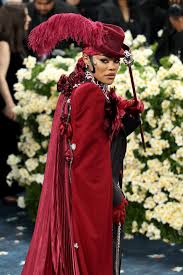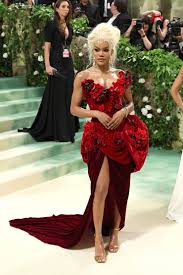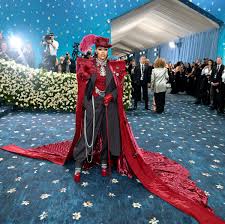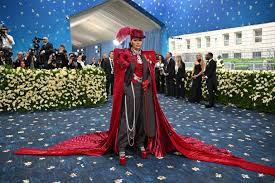Each year, the Met Gala transcends fashion—it becomes a tableau of culture, identity, and innovation. And in 2025, among the many standout ensembles gracing the Met steps, Teyana Taylor’s “Dandy” look emerged as one of the most powerful, stylish, and historically resonant statements of the night. With a look masterfully crafted by legendary costume designer Ruth E. Carter, Taylor honored the Black dandy tradition while adding her signature Harlem edge. Her ensemble told a story far beyond the red carpet—it was about identity, resistance, elegance, and style as a tool of liberation.
In this exclusive look behind the scenes, we explore Teyana Taylor’s final fitting, the meaning behind her 2025 Met Gala look, and why it struck such a chord with fashion critics, historians, and fans alike.
The Theme: “Superfine – Tailoring Black Style”
The 2025 Met Gala celebrated the theme: “Superfine – Tailoring Black Style”. Inspired by centuries of Black fashion innovation and resilience, the exhibition at the Costume Institute spotlighted how Black communities across the diaspora have historically used fashion as a language of expression, protest, celebration, and identity. From the Harlem Renaissance to 1960s mod, and contemporary streetwear to West African ceremonial dress, the theme demanded both reverence and reinvention.
And few understood the assignment as completely as Teyana Taylor.
Conceptualizing the Look: The Vision of Ruth E. Carter
To bring the vision to life, Taylor partnered with Ruth E. Carter, the first Black woman to win an Academy Award for Costume Design (notably for her work in Black Panther and Malcolm X). Carter is revered not only for her aesthetic sensibilities but also for her ability to root style in deep cultural and historical significance.
Together, they envisioned a look that would reinterpret the classic 19th and early 20th-century Black dandy—men (and some women) who wore tailored suits, elaborate accessories, and carried themselves with regal elegance as an act of resistance against racist notions of inferiority. In a world that denied them status, the Black dandy used style as armor.
But Carter and Taylor didn’t merely replicate history—they reinvented it.

The Final Fitting: A Moment of Transformation
In the final fitting, documented by stylists and photographers, Taylor’s transformation was palpable. As soon as she slipped into the ensemble—a tailored pinstripe suit layered under a sumptuous, floor-length red velvet cape emblazoned with “Harlem Rose”—her posture changed. She became the embodiment of her Harlem roots, radiating confidence and command.
Her longtime stylist, King Carter, noted the change: “She wasn’t just trying the look on. She became the look. She became the narrative.”
That cape, a standout piece, was more than fashion—it was metaphor. “Harlem Rose” referenced both beauty born in adversity and Taylor’s personal evolution from singer-dancer-actress to cultural icon. The look featured feathered embellishments, a structured wide-brimmed hat, and a walking cane—each a symbolic nod to Harlem’s history, Black excellence, and dandy flair.
The Elements of Dandyism: Decoding the Details
Let’s break down the major elements that made Teyana Taylor’s look both stylish and significant:
1. The Red Velvet Cape
Dramatic, regal, and deeply symbolic. The crimson hue was a bold declaration of visibility and pride. Velvet, historically associated with nobility, emphasized Black royalty and richness.
2. The Pinstripe Suit
A perfectly tailored, double-breasted suit under the cape honored the long-standing tradition of Black tailoring, particularly prominent in Harlem’s storied past. It referenced both Duke Ellington’s jazz-era elegance and the hip-hop infused suiting of the ’90s.
3. Feathered Hat and Cane
Both items paid homage to the tradition of the “Sunday Best”—how Black folks dressed their finest for church and social gatherings. The hat’s drama and the cane’s stateliness spoke to elegance and control in an often hostile world.
4. Footwear and Accessories
Taylor wore low-heeled oxford boots, polished yet practical, ensuring comfort without compromising on style. A gold pinky ring and jeweled brooch were finishing touches that echoed both hip-hop jewelry culture and Victorian fashion.

Style as Resistance and Celebration
Teyana’s look did more than earn her best-dressed accolades—it told a story. It was a wearable lesson in how style becomes a form of resistance. Throughout American history, Black people were often denied access to luxury and high fashion. But through ingenuity, tailoring skills, and expressive flair, Black style thrived and evolved.
The dandy tradition, in particular, disrupted white expectations. When Black men and women dressed with heightened elegance, they claimed space in a society that sought to erase them. Carter and Taylor’s interpretation drew a straight line from those historical roots to contemporary Black pride.
The Influence of Harlem: A Love Letter
Central to Teyana Taylor’s fashion philosophy is Harlem—her birthplace and an eternal muse. Harlem is not just a neighborhood; it’s a cultural powerhouse, the birthplace of jazz, hip-hop, Black arts, and fashion revolutions. The Harlem Renaissance, in particular, sparked a global awareness of Black artistic excellence.
“Harlem is my foundation,” Taylor once said in an interview. “It raised me. Everything I am—my walk, my talk, my style—it’s all Harlem.”
This love letter to Harlem was embroidered in literal form (on her cape) and metaphorical form (in her styling choices). In doing so, she brought Harlem to the Met steps—a global stage that has often neglected Black neighborhoods as sources of high culture.
Cultural Reception: Applause from All Fronts
Fashion critics were unanimous in their praise of Taylor’s Met Gala look. Vogue readers voted her among the top best-dressed, citing her “fusion of historical homage and modern mastery.” Essence hailed it as “the most authentic interpretation of the theme,” while GQ praised its “unapologetic tailoring and Black pride.”
Social media buzzed with admiration. Fans on Twitter and Instagram called the look “powerful,” “queenly,” and “a dissertation in fashion form.” Her ensemble sparked discussions not just on style but on legacy—particularly among younger Black audiences who saw in Taylor’s outfit a reflection of their history and future.
Fashion as a Form of Black Storytelling
Teyana Taylor’s ensemble wasn’t a costume—it was a story. And that story was centuries in the making. From the days when Black slaves used fashion scraps to craft Sunday wear, to the zoot suits of the 1940s, to the elegance of Black Wall Street, to today’s Afrofuturist fashion, Taylor’s look encapsulated a long and rich tradition.
Fashion has always been a medium of Black storytelling. Whether through hairstyles, fabrics, patterns, or silhouettes, Black communities have consistently turned to self-presentation as a way of preserving culture, expressing autonomy, and imagining new futures.

Legacy in Motion: What This Look Means Moving Forward
Taylor’s Met Gala look will likely become part of the ongoing conversation about representation in fashion—not just who is seen, but how they’re seen.
It’s no small feat for a woman like Teyana Taylor—who has danced between industries as a singer, actress, and creative director—to be seen as a fashion leader. Her look challenges the industry to reckon with its history of exclusion and to embrace the depth and variety of Black style.
Already, stylists and designers have begun referencing the “Harlem Rose” look in their collections. Students of design and fashion historians are dissecting its meaning. And Taylor herself has hinted at turning this experience into a fashion capsule or visual art piece.
Final Thoughts: Fashion Beyond the Fabric
In a night filled with tulle, diamonds, and drama, Teyana Taylor’s Met Gala ensemble stood apart because it wasn’t just about aesthetics. It was about identity. It was about place. It was about pride.
In a single look, she carried Harlem on her shoulders, wore resistance on her sleeves, and walked into one of fashion’s most elite spaces with the poise of a queen and the swag of a legend.
And in doing so, Teyana Taylor didn’t just wear fashion—she made fashion. Fashion with a soul. Fashion with a history. Fashion with a future.



